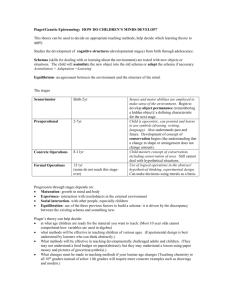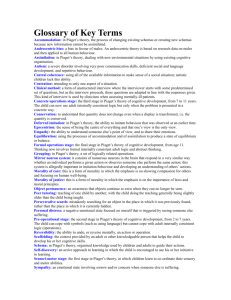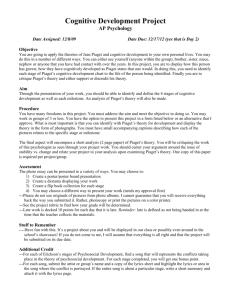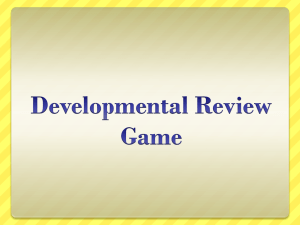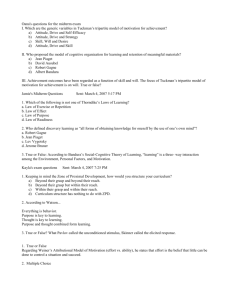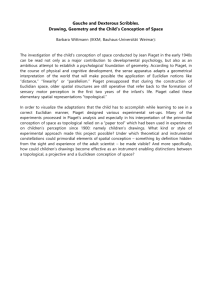A Practical Understanding of Piaget`s concepts of
advertisement
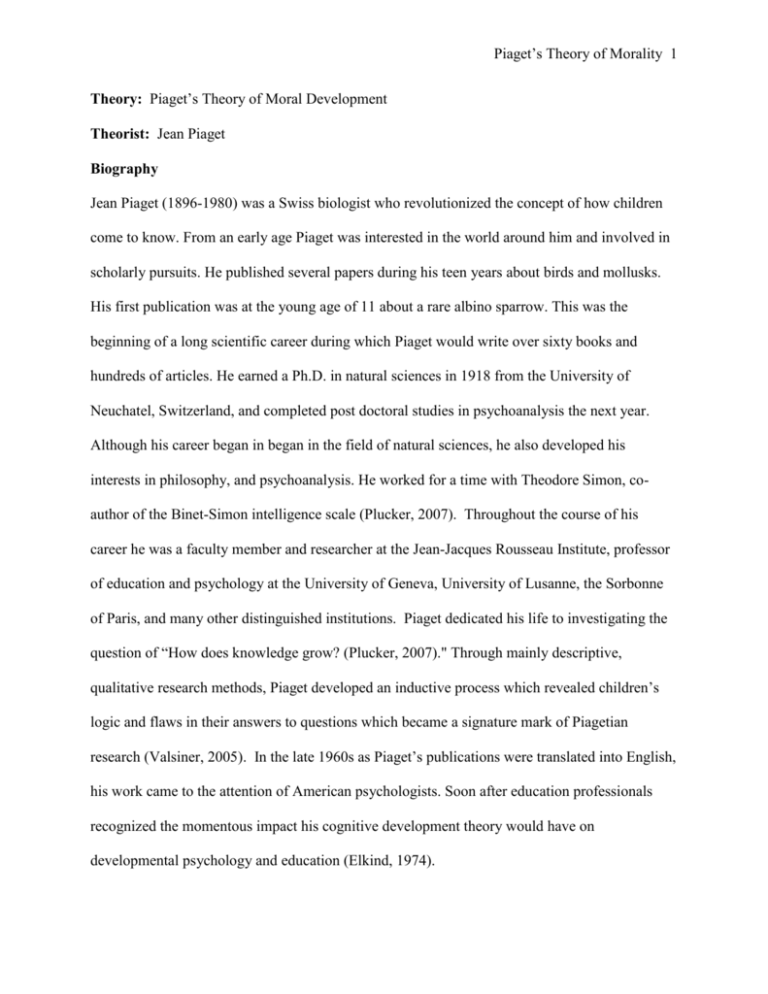
Piaget’s Theory of Morality 1 Theory: Piaget’s Theory of Moral Development Theorist: Jean Piaget Biography Jean Piaget (1896-1980) was a Swiss biologist who revolutionized the concept of how children come to know. From an early age Piaget was interested in the world around him and involved in scholarly pursuits. He published several papers during his teen years about birds and mollusks. His first publication was at the young age of 11 about a rare albino sparrow. This was the beginning of a long scientific career during which Piaget would write over sixty books and hundreds of articles. He earned a Ph.D. in natural sciences in 1918 from the University of Neuchatel, Switzerland, and completed post doctoral studies in psychoanalysis the next year. Although his career began in began in the field of natural sciences, he also developed his interests in philosophy, and psychoanalysis. He worked for a time with Theodore Simon, coauthor of the Binet-Simon intelligence scale (Plucker, 2007). Throughout the course of his career he was a faculty member and researcher at the Jean-Jacques Rousseau Institute, professor of education and psychology at the University of Geneva, University of Lusanne, the Sorbonne of Paris, and many other distinguished institutions. Piaget dedicated his life to investigating the question of “How does knowledge grow? (Plucker, 2007)." Through mainly descriptive, qualitative research methods, Piaget developed an inductive process which revealed children’s logic and flaws in their answers to questions which became a signature mark of Piagetian research (Valsiner, 2005). In the late 1960s as Piaget’s publications were translated into English, his work came to the attention of American psychologists. Soon after education professionals recognized the momentous impact his cognitive development theory would have on developmental psychology and education (Elkind, 1974). Piaget’s Theory of Morality 2 Theory of Moral Development Consider the following childhood scenario: Four children are playing a board game together. Dirk, age 6, is losing the game. He attempts to take a second turn in a row, insisting he can have a second turn since he is losing. The other children protest. He nastily knocks his game piece off of the board. Bobby, age 10, tells the teacher that Dirk is not following the rules. She tells Dirk to sit in the time out corner. The next day the children are again playing the board game. As Bobby reaches to move his game piece, he loses his balance and places his elbow into the middle of the board. All of the pieces bounce around, and fly off of the board. Dirk complains to the teacher. The teacher asks Bobby, “Did you do it on purpose, or was it an accident?” Bobby replies that it was an accident. The teacher responds in agreement. She directs all four children to go back to playing the game. Dirk, upset by the teacher’s solution, asks, “It’s not fair! Yesterday I knocked off one piece and I had to sit in the time out corner? How come Bobby doesn’t have to? He knocked off all the pieces!” Bobby interjects, “It’s fair because you did it on purpose!” Dirk just doesn’t understand, and continues to insist it isn’t fair. This is a typical early childhood scenario. Bobby and Dirk’s different perspectives in this scenario are explained by Jean Piaget’s Theory of Morality (Piaget, 1932/1997). Piaget believed there is a relationship between a child’s cognitive stage and their ability to reason about moral issues. He suggested that moral reasoning develops in predictable stages which reflect the cognitive stages. Moral reasoning considers how children respond to situations involving moral Piaget’s Theory of Morality 3 conduct. Piaget divided the development of moral reasoning into two stages. Each stage describes a child’s respect for social rules and a child’s sense of justice (Piaget, 1932/1997). Piaget called the first stage is called Heteronymous Morality, or moral realism (Piaget, 1932/1997). He believed children younger than seven years old reasoned using the characteristics of this stage. Before the age of four the overriding cognitive characteristic of egocentrism limits children’s respect for social rules. They are cognizant only of their own perspective and have no sense of obligation to rules at all. Preschool children are aware of the rules for games; however, these young children will only imitate the actions of the rules, and vary the rules to favor their best interests. In the story above, Dirk’s egocentric thinking justified a second turn, thus using his own set of rules to accommodate his own needs. It is typical of children in this stage to insist they know the rules, yet accommodate their egocentric perspective by inventing new rules (Piaget, 1932/1997). When expected to accommodate and comply with the laws and rules of society, these young children have constrained understanding (Slavin, 2009). A parent, when insisting on buckling a child’s seatbelt, may attempt to explain the reason for the seatbelt law. If told the reason for buckling a seatbelt is to prevent injury should car should stop suddenly, then the child may resist using a seatbelt, believing an injury will result due to the fastening of the seatbelt. The principles of the laws are unable to be internalized due to the limiting Preoperational structures. Closer to the end of this stage, around the age of seven or eight, as the influence of egocentrism, and other Preoperational characteristics, begin to decline, children naively accept rules, or laws, as external, absolute, and unchangeable (Piaget, 1932/1997). It is possible that in the heteronomous stage their extrinsic reasoning can lead them to consider violation of a traffic law to be comparable to a capital offence, such as murder. Secular rules, such as guidelines for Piaget’s Theory of Morality 4 getting presents from Santa, may be considered to be on par with sacred edicts, such as the Ten Commandments. They can become convinced that laws, and rules, are created by an external ultimate authority, and are to be revered. This omnipotent focus could be owed, at least in part, to the Preoperational property of centration. Piaget posited that the Preoperational stage is also reflected in the heteronomous stage of morality through the child’s sense of justice (Piaget, 1932/1997). The extrinsic focus of authority reveals the young child’s certainty of immanent justice; the belief that wrong doing inevitably leads to punishments. Young children believe that delivery of justice, or punishment, occurs automatically. Similarly, those who are punished are thought to be receiving their just reward, regardless of innocence, or guilt. Heteronomous childrenevaluate another child’s behavior, as well as their own, in terms of actual consequences, especially if negative, and do not consider the intentions of the actor (Slavin, 2009). In the opening story, Dirk does not consider the opposing intentions by which both he and Bobby knocked game pieces off the board. By focusing only on the physical consequences of the end result, Dirk, like heteronomous children, can not reconcile any variance in distribution of punishment. Piaget proposed that children in the heteronomous stage are not able to dualistically consider both the intentions and the consequences of the actions (Piaget, 1932/1997). Individuals age seven and older however, comprehend both the significance of considering intentions, and the consequences of the actions, in mediating justice. In the vignette Bobby is in the second stage of Piaget’s Morality, called Autonomous morality. At this stage children can broadly consider enforcement of rules, and laws from multiple perspectives. Adults, who also operate with Autonomous reasoning, inherently recognize the importance of intentions when dispensing punishment. In order for the teacher in the scenario to consider the circumstances of the situation Piaget’s Theory of Morality 5 she questioned Bobby’s intentions. This common questioning of a child’s intentions provides children with a covert message of the significance of one’s intent. Unfortunately, due to heteronomous limits these children cannot uncover the hidden lesson in the adult’s inquiry. Autonomous children, however, can comprehend implications of the teacher’s question, and the distinctions of the individual’s intent, and evaluate the event’s circumstances. Fairness of punishment is now defined by taking into account the individual’s purpose and the appropriateness of punishment to the offence (Piaget, 1932/1997). Cognitive development and the development a child’s moral development are correlated into both aspects of Piaget’s theories. Integration of these concepts into the academic experience of the child is an essential curriculum component. Compliance with the principles of Piaget’s theories requires the effective educator to assume that schools don’t simply have a responsibility to assist students with their cognitive advancement; they also have a responsibility to help them develop moral reasoning which will guide their choices and behavior. Prepared by: Cindi H. Fries, Oklahoma State University, Fall 2008 References Elkind, D. (1974). Children and Adolescents: Interpretive essays on Jean Piaget. New York, Oxford University Press. Furth, H. (1970). Piaget for teachers. N.J.: Prentice-Hall, Inc. Owens, K. (1993). The World of the Child. N.Y.:Macmillian Publishing Co. Piaget, J. (1997). The Moral Judgement of the Child. (translated by M. Gabian). New York: Free Press Paperbacks. (originally published in 1932). Plucker, J. A. (2007). Jean Piaget Swiss Biologist and Child Psychologist. Retrieved September 12, 2008 from http://www.indiana.edu/~intell/piaget.shtml Piaget’s Theory of Morality 6 Pulaski, M. A. S. (1980). Understanding Piaget. N.Y.: Harper &Row, Publishers. Slavin, R. E. (2009). Educational Psychology Theory and Practice (9th ed). Upper Saddle River Pearson. Valsiner, J. (2005). Participating in Piaget. Society, 42 (2), 57-61.Retrieved from EBSCO Host September 11, 2008.
